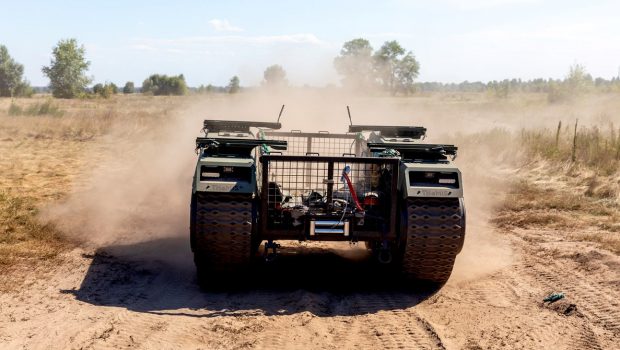Robots Are Fighting Robots in Russia’s War in Ukraine
Near the Ukrainian city of Avdiivka, a boxy robot zips along the rocky, cracked road. Snaking from side to side, the robot—a four-wheeled machine, around knee height—carries cargo and ammunition for Russian troops. However, it’s being watched. Hovering above the road, tracking the movements of the robot, is a Ukrainian drone. Suddenly, another drone smashes into the robot, blowing it to pieces.
The attack, which happened in early December and was claimed by the Ukrainian military’s 110th Mechanized Brigade, is one of a small but growing number of incidents where unsophisticated robots have been used against other robots in Russia’s war in Ukraine. Aerial drones have been used to surveil or attack ground robots, soldiers have attached weapons to land-based robots, and other small unmanned bots are being fitted with jamming technology to knock drones from the sky.
Since Russia’s full-scale invasion in February 2022, small aerial drones have played an outsize role in the war in Ukraine—with thousands of drones being used to monitor the battlefield, watch enemy movements, and carry explosives. Videos produced by Ukrainian and Russian soldiers show the drones, which are often first-person view (FPV) drones, being used to attack tanks and troops. As the war has raged on, another kind of robot has increasingly appeared in recent months: the unmanned ground vehicle, or UGV.
“There’s lots of unmanned ground vehicle development happening,” says Samuel Bendett, a Russia analyst at the think tank Center for Naval Analyses who tracks military drone and robotics technology use. Most of the UGVs being developed or used are small robots, Bendett says, as larger vehicles will be tracked, observed, and attacked with FPV and other aerial drones. “The Ukrainian battlefield is saturated with aerial sensors that basically track and attack anything that moves,” he says. That includes other robots.
The UGVs being developed within the war are typically four- or six-wheeled machines that can be kitted out for multiple purposes. There are logistics robots, which can carry supplies to the front lines; evacuation robots that carry injured people; and robots linked to combat such as those that can place or destroy landmines and have explosives or weapons attached. These robots are largely remote-controlled by humans—there’s little autonomy—and operate over ranges of a few kilometers.
UGVs themselves are not new. Some of the earliest UGVs were created in World War II and used as explosive devices, while they have also appeared in other conflicts. Most Russian UGV developments so far have been homemade or DIY, Bendett says, with troops or volunteers creating robots for specific tasks or needs. Ukraine has, to date, put more military effort into developing ground robots, with the government stating its ambition to build an “army of robots.”
Videos from within Ukraine, first shared on Telegram channels and reviewed by analysts such as Bendett, show a Russian drone monitoring a Ukrainian UGV as it trundles along laying mines. In another video, a small six-wheeled robot approaches a downed drone, lifting up its wings, before troops approach it. A third shows drones trying to destroy UGVs moving along the ground. In one demonstration, a person is dragged behind a UGV along the ground. Earlier in January, Mykhailo Fedorov, Ukraine’s deputy prime minister, announced a UGV with an “automated turret” that, he said, can also transport ammunition and provisions to fighters.








Gloss